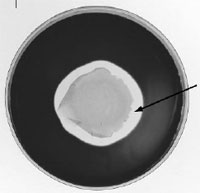Starch Hydrolysis
Some microorganisms split apart (hydrolyze) large organic molecules and then use the component parts in further metabolic processes. Starch is a polysaccharide that is hydrolyzed by some bacteria. When iodine is added to the intact starch molecule, a blue-colored complex forms. If starch is hydrolyzed by bacterial enzymes, however, it is broken down to simple sugars (glucose and maltose) that do not complex with iodine, and no color reaction is seen.The medium for this test is a nutrient agar containing starch, prepared in a petri plate. The organism to be tested is streaked on the plate. When the culture has grown, the plate is flooded with Gram’s iodine solution. The medium turns blue in all areas where the starch remains intact. The areas of medium surrounding organisms that have hydrolyzed the starch remain clear and colorless (see fig. 17.1).
| Purpose | To distinguish bacterial species on the basis of starch hydrolysis |
| Materials | Starch agar plates Slant cultures of Escherichia coli, Pseudomonas aeruginosa, and Bacillus subtilis Gram’s iodine solution |
 |
| Figure 17.1 Bacillus subtilis colony on a culture medium containing starch. The culture plate has been flooded with a weak iodine solution, which reveals a zone of clearing around the colony (arrow). This zone represents the area where the starch has been hydrolyzed so that it is no longer available to react with the iodine solution. |
- Take one starch plate, invert it, and with your marking pencil mark three triangular compartments on the back of the dish.
- Inoculate one section of the agar with E. coli, using back-and-forth streaking; another section with B. subtilis; and the third with P. aeruginosa.
- Label each section of the plate on the back of the dish with the name of the organism streaked in that area.
- Incubate 24 to 48 hours at 35°C.
- When the cultures have grown, drop Gram’s iodine solution onto the plate until the entire surface is lightly covered.
Results
Read and record your results in the table.
 |




